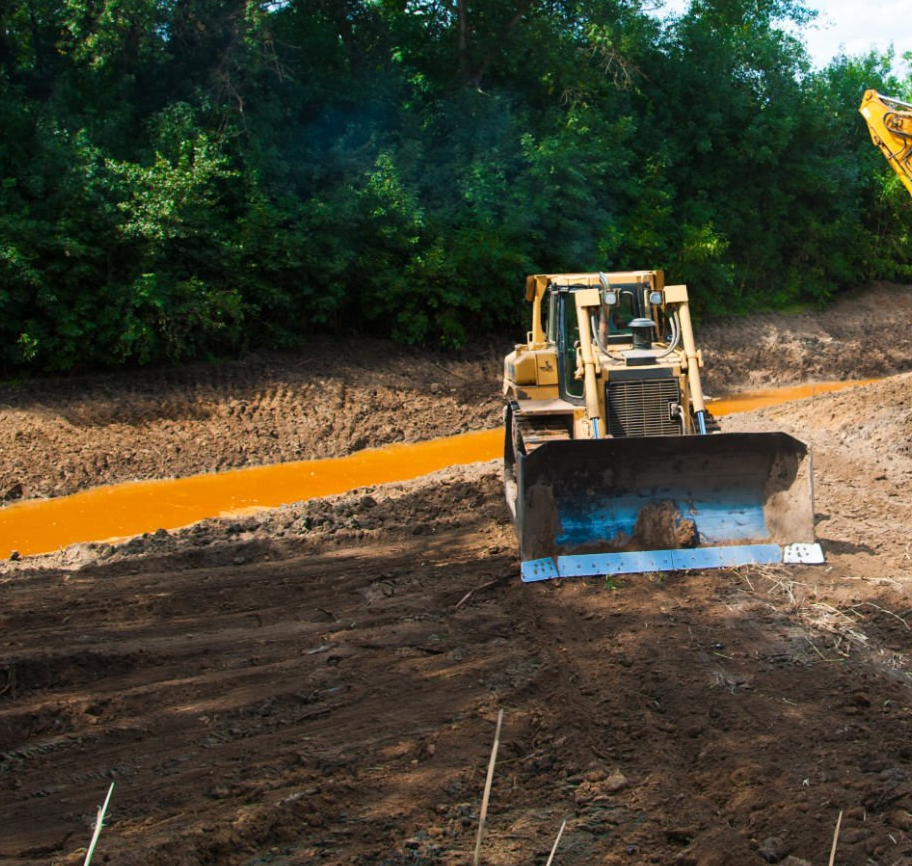Phillips Industries is a leading company in the field of site clearing for construction projects. With years of experience and expertise, they have established themselves as a trusted name in the industry. Site clearing is an essential step in any construction project, as it involves the removal of trees, vegetation, rocks, and other obstacles to make way for the construction process. It is crucial to ensure that the site is properly cleared before construction begins to avoid any delays or safety hazards.
Key Takeaways
- Phillips Industries emphasizes the importance of construction site clearing for safety, efficiency, and environmental sustainability.
- Planning is key to efficient site clearing, and Phillips Industries recommends conducting a thorough site assessment and developing a detailed plan.
- Safety is a top priority for Phillips Industries, and they provide guidelines for safe site clearing practices, including proper training and equipment use.
- Equipment selection and maintenance are crucial for effective site clearing, and Phillips Industries recommends using reliable, well-maintained equipment.
- Environmental considerations are also important, and Phillips Industries advocates for best practices such as minimizing soil disturbance and preserving natural habitats.
Planning for Efficient Construction Site Clearing Best Practices by Phillips industries: Tips from Phillips Industries
Efficient site clearing requires careful planning and preparation. Before construction begins, it is important to map out the site and identify potential obstacles that may need to be removed. This includes trees, vegetation, rocks, and any other structures that may hinder the construction process. By having a clear plan in place, construction companies can save time and resources during the site clearing phase.
One tip from Phillips Industries is to conduct a thorough survey of the site before starting any clearing activities. This will help identify any potential hazards or obstacles that may need special attention or equipment for removal. Additionally, it is important to consider the logistics of site clearing, such as access points for heavy machinery and disposal areas for cleared materials. By addressing these factors in the planning phase, construction companies can ensure a smooth and efficient site clearing process.
Safety First: Phillips Industries’ Guidelines for Safe Site Clearing
Site clearing can be a hazardous activity if not done properly. There are several potential hazards that need to be considered and addressed to ensure the safety of workers and the surrounding environment. One of the main hazards is falling trees or branches, which can cause serious injuries or even fatalities. Phillips Industries emphasizes the importance of proper training for workers involved in site clearing activities to ensure they are equipped with the necessary skills and knowledge to safely remove trees and vegetation.
Another potential hazard is the presence of underground utilities, such as gas lines or electrical cables. Before any digging or excavation takes place, it is crucial to conduct a thorough survey of the site to identify the location of these utilities. This will help prevent accidents and damage to infrastructure during the site clearing process. Phillips Industries also recommends the use of proper personal protective equipment (PPE) for workers, such as hard hats, safety glasses, and gloves, to minimize the risk of injuries.
Equipment Selection and Maintenance: Phillips Industries’ Recommendations

Selecting the right equipment for site clearing is essential for ensuring efficiency and safety. Phillips Industries recommends using equipment that is specifically designed for site clearing, such as bulldozers, excavators, and tree removal machines. These machines are equipped with specialized attachments and features that make them suitable for clearing vegetation, removing rocks, and leveling the ground.
Regular maintenance of equipment is also crucial to ensure safe and efficient site clearing. Phillips Industries recommends conducting routine inspections and servicing of equipment to identify any potential issues or malfunctions. This includes checking fluid levels, inspecting hydraulic systems, and replacing worn-out parts. By properly maintaining equipment, construction companies can avoid breakdowns and delays during the site clearing process.
Environmental Considerations: Phillips Industries’ Best Practices for Site Clearing
Site clearing can have significant environmental impacts if not done properly. It can lead to soil erosion, loss of habitat for wildlife, and disruption of natural ecosystems. Phillips Industries is committed to minimizing these impacts through best practices for site clearing.
One of the key practices recommended by Phillips Industries is erosion control. This involves implementing measures to prevent soil erosion during the site clearing process. This can include installing erosion control blankets or mats, planting cover crops, or using sediment barriers to prevent runoff into nearby water bodies.
Preserving natural habitats is another important consideration during site clearing. Phillips Industries recommends conducting a thorough assessment of the site to identify any sensitive or protected areas that need to be preserved. This may include wetlands, forests, or habitats of endangered species. By working with environmental experts and following guidelines set by regulatory agencies, construction companies can ensure that site clearing activities do not harm these valuable ecosystems.
Dealing with Hazardous Materials: Phillips Industries’ Protocols for Safe Removal

Construction sites may contain hazardous materials that need to be safely removed during the site clearing process. These materials can include asbestos, lead-based paint, or chemicals stored on the site. Phillips Industries emphasizes the importance of following proper protocols for the safe removal and disposal of hazardous materials.
Before starting any site clearing activities, it is crucial to conduct a thorough assessment of the site to identify any potential hazardous materials. This may involve testing samples of building materials or soil for the presence of contaminants. If hazardous materials are found, it is important to engage the services of qualified professionals who are trained in their safe removal and disposal.
During the site clearing process, it is important to handle hazardous materials with care and follow all safety guidelines. This may include wearing appropriate PPE, using specialized equipment for removal, and properly sealing and labeling containers for disposal. By following these protocols, construction companies can ensure the safety of workers and prevent any potential environmental contamination.
Site Restoration: Phillips Industries’ Strategies for Restoring the Site to its Natural State

After construction is complete, it is important to restore the site to its natural state as much as possible. This involves reseeding and replanting vegetation, restoring natural drainage patterns, and repairing any damage caused during the construction process. Phillips Industries recommends developing a site restoration plan before construction begins to ensure that all necessary steps are taken.
One strategy recommended by Phillips Industries is reseeding and replanting vegetation. This helps prevent soil erosion and restores the natural habitat for wildlife. It is important to use native plant species that are adapted to the local climate and soil conditions. Additionally, implementing erosion control measures, such as installing erosion control blankets or mats, can help stabilize the soil and prevent erosion during the restoration process.
Repairing any damage caused during the construction process is also crucial for site restoration. This may include filling in holes or trenches, repairing damaged infrastructure, or restoring natural drainage patterns. By addressing these issues promptly, construction companies can ensure that the site is restored to its natural state and minimize any long-term impacts.
Recycling and Waste Management: Phillips Industries’ Approach to Sustainable Site Clearing
Sustainable site clearing practices are becoming increasingly important in the construction industry. Phillips Industries is committed to recycling and waste management during the site clearing process to minimize environmental impacts.
One approach recommended by Phillips Industries is proper disposal of materials. Construction debris, such as concrete, wood, or metal, should be sorted and disposed of in designated recycling or waste management facilities. This helps reduce the amount of waste sent to landfills and promotes the reuse of materials.
Another approach is recycling whenever possible. Phillips Industries recommends identifying materials that can be recycled, such as concrete or asphalt, and working with recycling facilities to ensure proper disposal. This not only reduces waste but also conserves natural resources and reduces the carbon footprint of construction projects.
Communication and Collaboration: Phillips Industries’ Tips for Effective Site Clearing
Effective communication and collaboration between all parties involved in site clearing are essential for a successful project. Phillips Industries emphasizes the importance of clear and open lines of communication to ensure that everyone is on the same page and working towards a common goal.
One tip from Phillips Industries is to establish regular meetings or check-ins with all stakeholders involved in the site clearing process. This includes construction managers, contractors, environmental experts, and regulatory agencies. These meetings provide an opportunity to discuss progress, address any concerns or issues, and make necessary adjustments to the site clearing plan.
Collaboration is also crucial during the site clearing process. By working together, construction companies can leverage the expertise and resources of all parties involved to ensure a safe and efficient site clearing process. This may include coordinating schedules, sharing equipment or resources, or seeking input from environmental experts on best practices for minimizing environmental impacts.
Phillips Industries’ Commitment to Safe, Efficient, and Sustainable Site Clearing Practices
In conclusion, Phillips Industries is committed to promoting safe, efficient, and sustainable site clearing practices in the construction industry. Through their expertise and experience, they provide valuable insights and recommendations for construction companies to follow.
By prioritizing planning, safety, equipment selection and maintenance, environmental considerations, hazardous material removal, site restoration, recycling and waste management, and communication and collaboration, construction companies can ensure that site clearing is done in a manner that minimizes r isks, maximizes efficiency, and protects the environment.
isks, maximizes efficiency, and protects the environment.
It is crucial for construction companies to prioritize site clearing practices that prioritize safety, efficiency, and sustainability. By doing so, they can not only ensure the success of their projects but also contribute to a more sustainable and environmentally conscious construction industry. With the guidance and expertise of companies like Phillips Industries, construction companies can achieve these goals and set a positive example for others in the industry.
If you’re interested in learning more about construction site clearing best practices, you may also find the article “Building Pad Contractor in Texas” by Phillips Industries to be informative. This article provides valuable insights into the process of preparing a building pad for construction, highlighting the importance of proper site clearing techniques. To read more about this topic, click here.
Texas Demolition | Texas Water Ponds | Texas Land Improvement | Texas Framing Contractor | Texas Lawn Care Services |
FAQs

What is construction site clearing?
Construction site clearing is the process of removing debris, vegetation, and other obstacles from a construction site to prepare it for building.
Why is construction site clearing important?
Construction site clearing is important because it ensures that the site is safe and ready for construction. It also helps to prevent delays and additional costs that can arise from unexpected obstacles during the construction process.
What are some best practices for construction site clearing?
Some best practices for construction site clearing include conducting a thorough site assessment, properly disposing of debris and hazardous materials, protecting the environment, and following all local regulations and guidelines.
What are some common obstacles that need to be cleared from a construction site?
Common obstacles that need to be cleared from a construction site include trees, rocks, brush, debris, and hazardous materials such as asbestos and lead.
What equipment is typically used for construction site clearing?
Equipment that is typically used for construction site clearing includes bulldozers, excavators, backhoes, skid steers, and dump trucks.
What are some safety considerations for construction site clearing?
Some safety considerations for construction site clearing include wearing appropriate personal protective equipment, properly securing equipment and materials, and ensuring that all workers are properly trained and supervised.
Page design by: Web Designer Near Me






